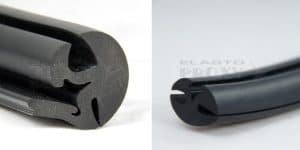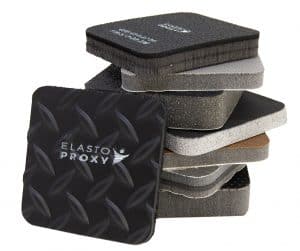Elasto Proxy uses precision cutting without tooling to fabricate products from rubber, plastic, and other types of materials. Unlike die cutting, knife cutting, or CNC cutting, our water jet equipment uses a highly-pressurized stream of water with or without an abrasive. With water jet cutting, you’ll never have to pay for tooling or wait for it to arrive. Plus, there’s no tooling to scrap if your part design changes. Water jet cutting is also faster than manual cutting and can maximize material yields.
Watch the video below and keep reading or contact Elasto Proxy about precision cutting.
How does water jet cutting work?
Water jet cutting is a form of digital manufacturing that converts your computer-aided design (CAD) files into coordinates that control the movement of tool-free cutting heads. First, a pump pressurizes water to tens of thousands of pounds per square inch (PSI). Next, this pressure is converted into velocity. Water travels into the cutting heads and a jewel orifice restricts the flow. With pure water jet cutting, high-pressure water cuts sheets or profiles on a large X-Y gantry table without the use of an abrasive.
What are some advantages of pure water jet cutting?
Pure water jet cutting makes fine, fast cuts for prototypes and low-to-medium production volumes. At Elasto Proxy, our gantry-style equipment can make cuts as small as 1/2-in. (1.27 cm) x 1/2” (1.27 cm). In addition to clean edges, chamfers, dovetail cuts, and 90° corners, water jet cutting can support part features such as small notches and vent holes. Plus, the cuts are always smooth, even, and consistent so that cut lengths are easier to bond. With sheet materials, parts can be nested to maximize material yields.
What about abrasive water jet cutting?
Pure water jet cutting is used with rubber, plastic, acoustic foams, and even some types of wood. Abrasive water jet cutting adds a garnet abrasive for cutting harder materials, soft materials that are thick, and rubber products that contain metal wires. At Elasto Proxy, our abrasive water jet cutter use a multi-axis robot for greater manufacturing freedom. With a worktable that spans 60” x 44” (152.4 cm x 111.76 cm), our abrasive water jet equipment can also cut larger parts.
What are some advantages of abrasive water jet cutting?
Abrasive water jet cutting can produce near-net shapes with excellent edge quality. Elasto Proxy has developed special clamps for making angled cuts and has considerable experience with cutting bulb trim, including parts with 90° corners and pockets in the middle. With our large worktable for abrasive water jet cutting, stacking and nesting can optimize material usage and reduce cutting times. Once your parts are cut, they’re easy to assemble.
What else do you need to know about water jet cutters?
Pure water jet cutting and abrasive water jet cutting are both cold cutting processes. They won’t create heat-effected zones or cause hardening that requires expensive secondary processing. With both types of cutting, any heat that is produced is cooled by the water stream. By contrast, laser cutting and CNC machining can cause warping, distortion, or material hardening. Plus, pure water jet cutting and abrasive water jet cutting are closed-loop processes that reuse water and won’t produce hazardous waste.
What’s the best way to get started with tool-less precision cutting?
Elasto Proxy is a value-added manufacturer that can recommend the right form of precision cutting for your products and projects. Whether your need pure water jet cutting or abrasive water jet cutting, we’re ready to review your part designs, help you material selection, and combine precision cutting with services like bonding, laminating, gasket taping, kitting, custom packaging, and warehousing.










